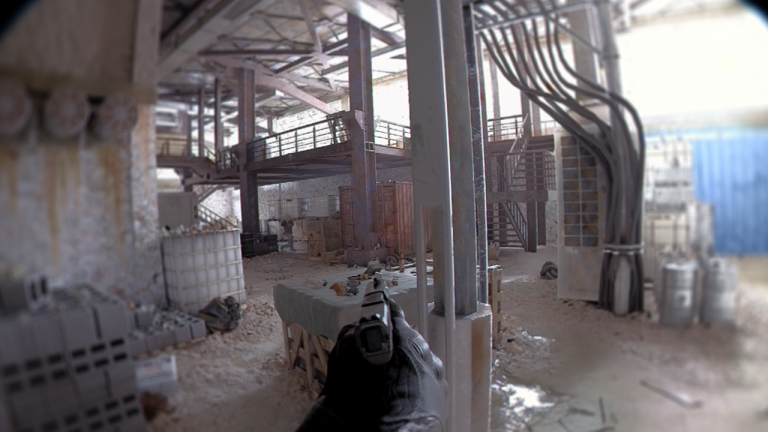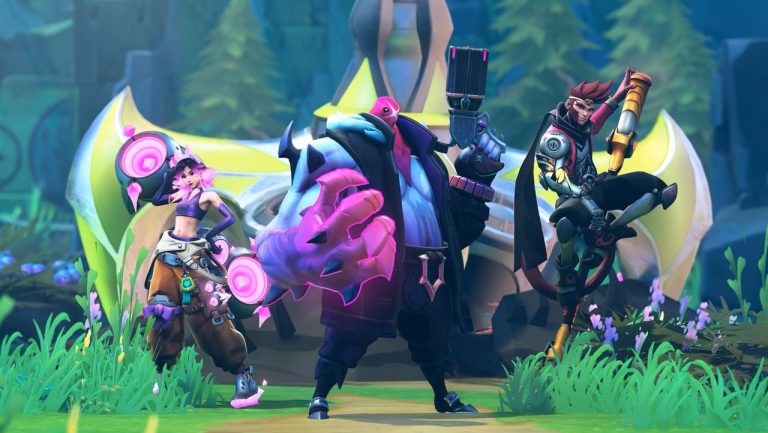This article first appeared in PC Gamer magazine issue 388 in September 2023, as part of our Reinstall series. Every month we load up a beloved classic—and find out whether it holds up to our modern gaming sensibilities.
Jet Set Radioooooooo!— yells DJ Profesor K, as the title screen bursts into life with a remix worthy of Fatboy Slim himself. The cel-shaded action skater game with a Y2K aesthetic and a cool electronic, funk and hip-hop soundtrack—that is still dynamite to this day, might I add—is undergoing a bit of a resurgence as of late. This has all stemmed from the lead-up and launch of Bomb Rush Cyberfunk, a spiritual successor that builds upon everything that made the original so damn engrossing.
Not that Jet Set Radio needs a renaissance. The fanbase and ever-lasting admiration for Beat, Gum and the ever-growing GGs gang has prevailed for more than two decades now, something pretty special considering only two mainline console games were released in the early 2000s.
My own personal history actually begins with Jet Set Radio Future, the 2002 sequel that somehow is still exclusive to the original Xbox. Seriously! It’s never been made available anywhere else, with licensing issues surrounding the music being the prevailing theory about why.
I’ll always remember when my father brought home a second-hand Xbox that was once owned by my cousins, and with it came the double game disc of Sega GT 2002 and Jet Set Radio Future. Being as immersed as I was by the poppy visuals, anti-establishment empowerment and Tony Hawk-like soundtrack, it’s sort of amazing I’ve never experienced the original release until now.
For those not in the know, the action arcade skate game is all about spraying graffiti across the three districts that make up the city of Tokyo-to. For the most part, you need to tag around 20 or so marks within a time limit to progress, all while avoiding local law enforcement, rival gangs and, sometimes, deadly assassins. There are other levels where you need to spray paint a rival’s back, alongside frequent opportunities to unlock new characters by racing to tag a graffiti spot first or by following in their slipstream perfectly. It’s all wonderfully simple.
Fan longevity
(Image credit: Smilebit)
I think that simplicity has contributed to Jet Set Radio’s longevity with fans. Within minutes, you know exactly what the rest of the game entails—and it never loses its charm, and never outstays its welcome, either. Eighteen missions to complete across three chapters, ranging between six to eight hours in gameplay, hits the sweet spot of what Jet Set Radio needs to be with enough replayability in pursuing the top rating (I’ll get there one day) to keep you coming back for more. My playthrough was made possible via the 2012 HD port of Jet Set Radio, which was included as part of Sega’s Heritage Collection series (available on Steam). It’s clear that while the core concept holds up miraculously, some of Sega’s original decisions and new ‘improvements’ to the port have not aged so well. For one, the camera. I can only assume the person documenting my skating antics was a bit worse for wear, having to constantly battle with walls, staircases and anything else en route whenever I was trying to figure out where to head next. Where’s Lakitu when you need him?
It never loses its charm, and never outstays its welcome.
The most bizarre decision of them all is an exit. There I am, skating along, minding my own business—and suddenly, a big ‘Exit’ notice appears above me. Found at the end of certain unsuspecting streets, for no reason whatsoever, it caught me out early on, losing a good run in the progress. A mistake I never made again. Still, it’s the reasoning behind the inclusion I can’t get over. We have a pause menu. Within that pause menu is an exit button. Surely that would make more sense than randomly placed exits. Look, I get it, I’m not a developer and the aim here is to simulate a city that appears never-ending, which does work to an extent. In spite of that, just put some orange cones down or use traffic to block the way out. It’s frightfully easy to think the level continues around the next corner… oh wait, now I’m back in the main menu. Terrific.
This might only be topped by the decision to show a cutscene every time you escape the police. Every. Single. Time. The law enforcers are constantly chasing you. It’s not like you can lose them and they’re gone forever. Nope! It can literally be moments before they scurry back into frame and there it is again, a two-second cutscene of the police waving their truncheons in my direction like an episode of the Three Stooges. It’s all very slapstick. I think there’s an interesting way to implement this too, just without the need to constantly interrupt gameplay.
One thing that I kind of unironically love is the audio dialogue overlay, both fighting it out to be heard through the airwaves. Was it this bad on the Dreamcast? Was this Christopher Nolan before he got into filmmaking? I don’t know, but the chaos of it all made me smile. Except perhaps for some more variety when it comes to the toggle direction puzzles for spraying graffiti, there’s really little else that needs changing. Sure, the jagged edges of the cel-shaded art style might resemble elements of a rejected Picasso by today’s standards. That in no way takes away from Jet Set Radio’s overall sense of fun.
Forever young
(Image credit: Smilebit)
Wanting to move away from the number of fantasy games on the market in the late ’90s, while also having just shipped Panzer Dragoon Saga for the Sega Saturn, Masayoshi Kikuchi and Ryuta Ueda moved onto Jet Set Radio as project lead and art director, respectively. This was a team said to be made up of fewer than 25 developers and with an average age of less than 25. Who says that youth is wasted on the young?
That wonderful sense of adolescence carries throughout Jet Set Radio, from the clothing to the vibrant streets to the use of music. Nothing embodies this more than the main titles’ anthem Let Mom Sleep from lead composer Hideki Naganuma. By taking the line of dialogue, “Would you stop playing with that radio, Lord? I’m trying to get to sleep!” from the 1950s BBC radio comedy, Hancock’s Half Hour, starring Tony Hancock (also featuring various Carry On stars, such as Sid James, Hattie Jacques and Kenneth Williams) it’s then remixed to a fast, modern beat. And cor blimey! Does it work!
That wonderful sense of adolescence carries throughout.
This only continues with its use of licensed music, including hip-hop group Jurassic 5, Japanese underground indie rock band Guitar Vader and even a bit of Rob Zombie thrown in there for good measure. If I played this as a teenager, there is no doubt that I would have downloaded each song individually to my MP3 player via LimeWire, and that really is the highest of accolades any of us can award.
What I like about the story is that it could easily be from an anime series, as influential businessman Gouji Rokkaku (voiced by Mario himself, Charles Martinet in the English version) seeks out a demon record to take over the world. It never distracts from the gameplay element, letting the characters shine instead. Beat and Gum may be the poster children, but goth girl Cube stole my heart, reminding me of an 18-month period when my wardrobe severely lacked any primary colours.
The real star, though, is DJ Professor K. Host of Jet Set Radio’s “premier pirate radio station”, the man behind the decks breaks down plot details in such a charismatic way that it’s impossible to not be taken in by his magnetism and witty lyrics. Billy Brown of How to Get Away with Murder fame is the one behind the mic, delivering pearls of wisdom like, “Brush those teeth boys and girls because a whole lot of trouble is heading your way”. He occasionally answers fan mail too, “We got a letter from Mr Owsaki. ‘How do I get rid of those nasty roaches?’ Easy. Burn your house down.” Duly noted.
Ever-expanding
(Image credit: Smilebit)
As one of the earliest games to feature an open 3D environment to explore, I appreciate how the city expands over the course of the narrative. Take Kogane-Cho for instance, where you start off in a residential area in one of the opening levels, returning time and time again to discover an expanded area, a construction site, and a whole sewer system to explore. It was only on my last visit that I realised these were interconnected and not separate—a huge accomplishment for the time.
And what really pulled me in from the beginning was the difficulty. There’s no settling in, with a decent challenge presented from the first five minutes, peaking in one of the final levels—Fight or Flight—where jetpack enemies swarm like a hive of bees around every turn. After a few deaths, I stumbled across a Reddit thread only a few years old aptly titled “I hate this level”.
Naturally, a lot of the locations featured are inspired by various settings across Tokyo, such as Shibuya and Shinjuku’s shopping districts. Bantam Street, on the other hand, is based on parts of south Bronx from New York City. Moreover, it’s the only place where a death of a character occurs, potentially pointing to gang violence in America. Or maybe I’m reading too much into this. It’s an interesting decision that happens unceremoniously offscreen and is never really touched upon again, for better or worse. Was this really the intention of Sega and Smilebit? Well, to pull some further words of wisdom from the amazing DJ Professor K, “On the streets, there’s no such thing as ‘The End.'”












